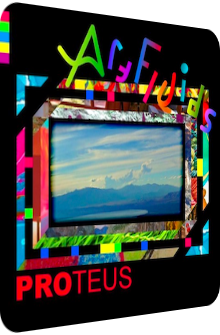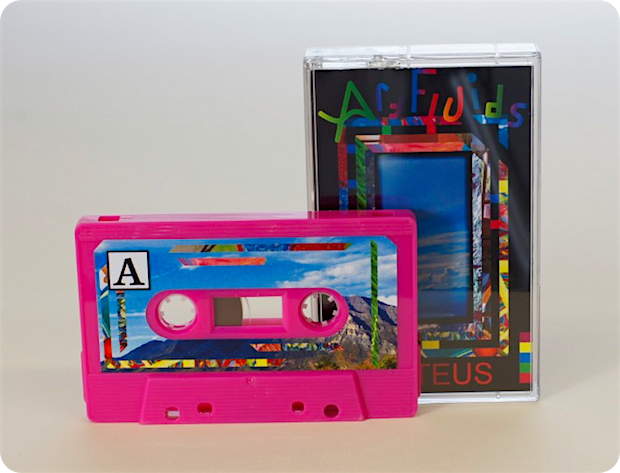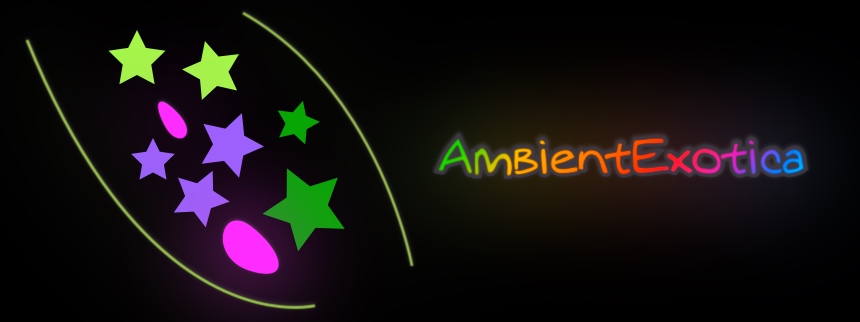
ArtFluids
Proteus
2015
It’s A Synthetic World…
When you consider the technicolor craze of the first outing by Massachusetts-based synth wizard Alexander aka ArtFluids, fittingly called Umami and self-released in 2014, you might have wondered how this orthochromatic cannelure of synthesizer goodness can probably be altered? Will the Rave undertones, Jungle ergosphere and technodrome titration be multiplied or lessened? After all, even artists that are more closely tied to the Vaporwave community mature against the general public’s opinion. The moment has come for ArtFluids to reveal the goods. After several tracks and singles that appeared in illustrious places and on compilations such as Dream Catalogue’s DREAM_100, Bedlam Tapes’ 死と音楽の復活 and the artist’s own SoundCloud page, the full-length follow up has materialized on Maxfield’s aka OSCOB’s Bedlam Tapes label in the rectangular pink shape of a wondrous – and sold-out – tape. The twelve-track epitome is called Proteus and can be fetched and streamed at Bandcamp. The world of Proteus is highly synthetic, realized by means of a large array of hardware synthesizers, beautiful melodies and surprisingly few sampled sources taken from somewhere else, with compositions dating as far back as 2011. Thereby, Proteus is the classical archetypal songwriter album, deliciously contiguous (or was that contagious?) and thankfully without the ubiquitous folksy bonfire guitar, thank you very much, though the artificial approximation of a harmonica does appear more than once in Proteus. Considering its mountainous front artwork, its inclusion is only fair. Stylistically, however, ArtFluids ventures into pyroxene synth fields, sumptuously texturized wraithlike bays and refreshingly elated locales. Two of its stylistic components are analyzed below, followed by a third paragraph about the utmost important goal of Alexander’s technical prowess.
 Blue skies, poppy colors, tied to the 80's? Vaporwave, I guess. Photographed by OSCOB.
Blue skies, poppy colors, tied to the 80's? Vaporwave, I guess. Photographed by OSCOB.
Acidic Arpeggio Amid Anthocyanin
Like ants in the jungle, like flashing lights reflected by the retina of an android, the endemics of Proteus are mercilessly arpeggiated: synth sequences are glistening, timbres experience an ongoing punctilio of vesiculating droplets, and let’s not forget the constant stop-and-go motion of the twitching, flickering but enormously melodious core. More about ArtFluid’s compositional qualities at a later point, this paragraph, for now, is dedicated to the pointillistic, pixellated scales. And they are rightfully introduced in the opener already. Called Ensoniqism, the suave title comes attached with paraphyletic vincristine dots which turn more silver, metallic and aglow as the track moves to its synth choir-fueled second phase. With the spliced and sliced ancillary arpeggio, an Ambient/Drone hydra has received a lively, helicoidal retinue that is more than mere addendum. In the meantime, the seventh track Retroactive doesn’t hide its Coldwave or (G)Low-Fi dance vision, presenting a catchy square lead melody over a four-to-the-floor wanderlust phragmoplast whose crystalline bongos are yet again runners-up to the actual showstopper, and that is the adaxial arpeggiocentrism that works as a substantive parallax layer that restrains from connecting the dots. Finally, Gaia’s Return shall be hailed for its tumular sound/silence string of dissipative sequences. Now much more cosmic and spaced out despite the title, these polygonal bits and monoclinic bytes bring back 303 lozenges and more granular rhenium-alloyed helictites, making Gaia’s Return the technocratic Space-Age vision within Proteus.
Stokehold Mist Caulks The Interstice
Moving along to the opposite side of the spectrum: when single tones or notes are agglutinated and melting via the power of glissando, a kind of droning diorama ensues, that is a harmonious sonority and colorful plateaus where the highs and lows fragilely oscillate around an average value or threshold. These contrapuntal instances help to lessen the flickering, scintillating densitometry of Proteus as ArtFluids injects the spherical synth-based trope found in Ambient and Vaporwave alike. And so it comes down to these three song-shaped examples that embody the lilting telomeres of legato washes, the first one being Raspberry Trash, a breakbeat proscenium where the healing powers of drone are found in an unexpected place, and indeed, it is a novelty within the album: here, the drones dock onto the bassline, making it somewhat thermal, mild and close to the Dub force. Everything around that line jogs, jitters and quavers, but the milquetoast hub remains the soothing sinecure. The adjacent CyberPaint Pro, on the other hand, is a volatile yttrium thrill whose pulsatile oxidants are amended via nomothetical stokehold gongs and ethereal magnetotails. The wonderful analog output in tandem with its playful mysticism brings back the 16-bit era of video games, but also outshines the – otherwise more luminescent – front line of muons and jigs. Later on, the panchromatic hue of Crystalline makes for an exciting ride, what with its immersive coruscation and tetragonal surfaces. With this short tune of two and a half minutes, ArtFluids mimics the superstructure of a crystal, with sharper edges, adiabatic gaps and rhombohedral spacing.
Uplifting Vibes, Euphonious Swipes
The former paragraphs concentrated on the shapes and states of the melodies, that is whether these most-important instances in music are choppy or nebulous, scything or mellow, prolonged and slowed-down or sped-up and boosted. What I have neglected to mention is the bewitching credibility that is encapsulated in every tone sequence. It is true that Proteus has its fair share of clandestine corkscrew chasms and recondite sundown cristae, but as they say, melody is king in the vast majority of the album’s runtime. All of the 12 tracks showcase Alexander’s talent for unique timbres, rotenone tones and sound-based sporophytes, but the following three examples are the most gregarious, eminently blissful corkers, almost bringing in overly oversaturated colors that are prone to flood the intrinsic gamut with their superfluidic appearance. Already reviewed in-depth in a recent Vapor Vertebrae writeup /vapor_vertebrae/vapor-vertebrae-10-2015-part-b.html is Avoc Cado, the album’s second track. What I realized and absorbed there still stands for me: the retrofuturistic crystal droplets and rain pads not only enchant on a textural level, they also create, maintain and fuel a superb 80’s vibe reminiscent of the sound demos and Atari stems of yesteryear. What I didn’t know back then is that the dark/neon dualism immediately leads to the crazily sun-kissed oompa/country iconoclasm that is Good Morning WinkyVille. MIDIfied mouth organs float through aureate Mellotron fibroblasts. Even the panoptic-portentous kaleidoscope at the end cannot kill off the sheer fun of that stratiform hymn of mutual understanding. Then there is Tears Falling Upwards which could well be interpreted as a second outing of sunshine, as its textures are closely attached to ArtFluids’ morning tune; the harmonica is yet again in the limelight, the matutinal synth choir tones feel celestial and the crystal pads in the center exude a salubrious chromaticity. Coupled with the square flutes, amethystine aureoles accrue.
… And A Happy One After All
Ultimately, Proteus overflows with happy music, and I’m not sure Bedlam Tapes boss Max and ArtFluids epitomizer Alexander would be perfectly content with that notion. But I for one absorb only the positive vibes, even in the darker instances and less colorful segues that ostensibly serve as bridges and connectors to the suprematism of the catchy melodies. My happiness is based on the complete package that is enshrined within the aural realm of Proteus: ArtFluids makes seriously delightful music, not overly much is sampled vocal-wise, there are no citations made in songs or quotes uttered in films, at least 99% of the time. The album rather encompasses the skills of a songwriter, and I cannot stress this enough, for Alexander is a synth wizard and has all the frequencies and surfaces close at hand… literally so, as his hardware collection and devotion to haptic keyboards and synthesizers is a potential unique selling proposition for him as an artist. Thankfully, he doesn’t get lost in the endless possibilities and rather pours an array of reappearing and cautiously altered textures, patterns and shapes into the angularly shaped ring. The playful front artwork does the innermost carefreeness and imminent insouciance justice while at the same time tempting veterans of the V-genre to dismiss the rainbow art and blue mountain skies as overused metaphors for a synthetic and cheap world. By all means, nothing could be farther from the truth: Proteus emits energy, radiates cathexis, inculcates catchiness in a unique listening experience that is admittedly less vaporwavy and much more keen on the heritage of late 70’s/early 80’s synth sybarites, but to me, ArtFluids always refers back to the mighty V due to the sizzling surprises, multinucleate genres and zoetropic rapture.
Further listening and reading:
- Tapes-a-gone, files available at Bedlam Tapes.
- ArtFluids talks about Umami, Proteus and synths on the OSCAST.
- Artist and label on Twitter: @ArtFluids @BedlamTapes
Vaporwave Review 137: ArtFluids – Proteus (2015). Originally published on Nov. 10, 2015 at AmbientExotica.com.
